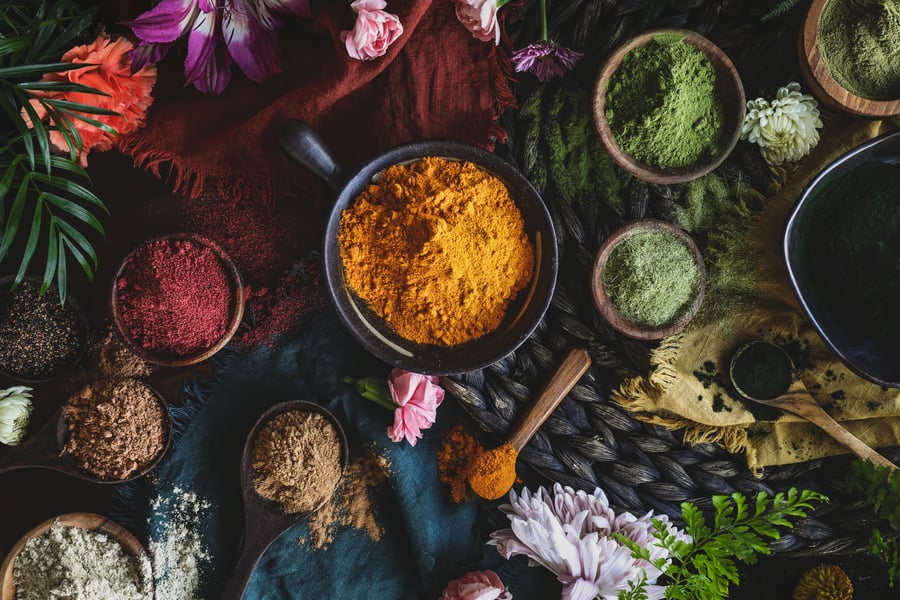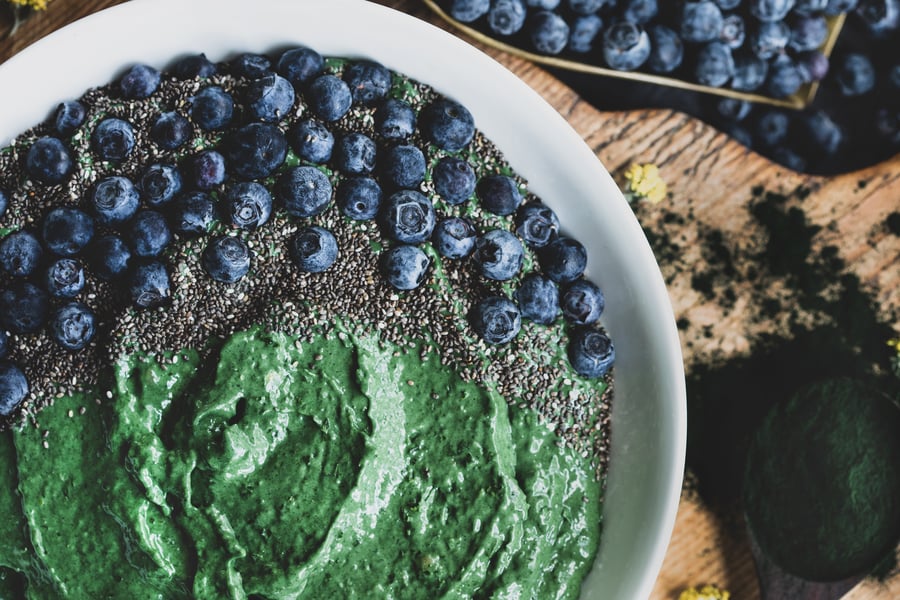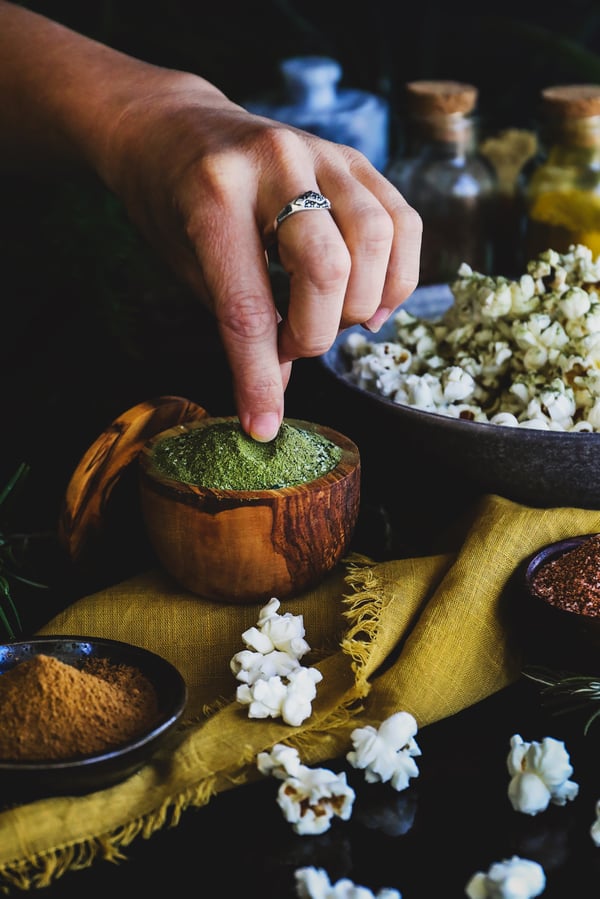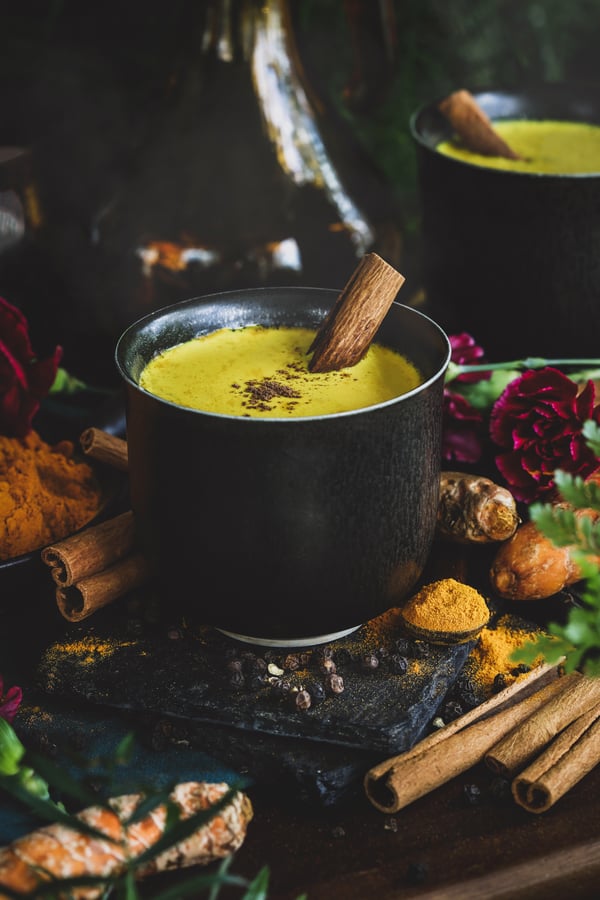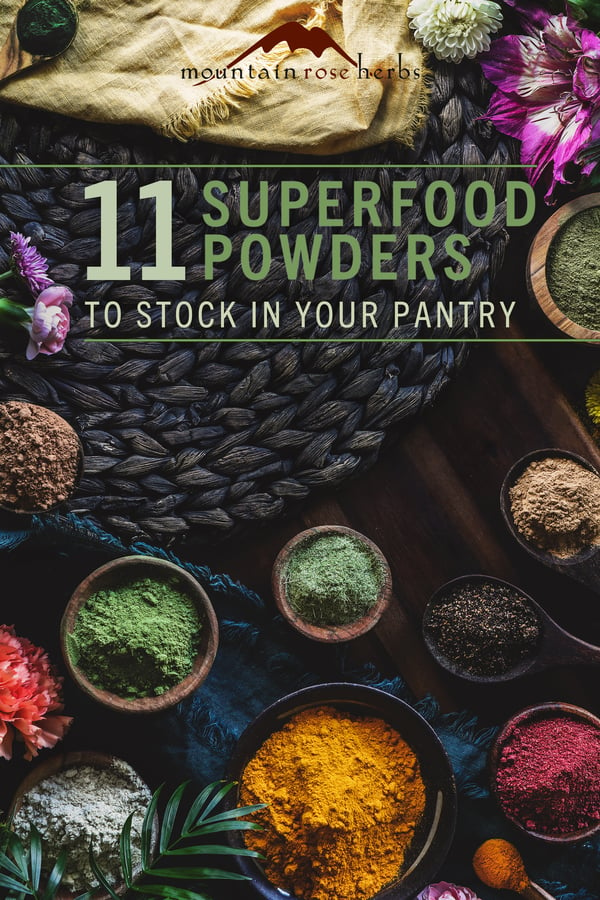Powdered herbs—whether we speak of culinary spices like cinnamon and garlic powder or nutritive herbs like acai, nettle leaf, and mushrooms—bring together the best of several worlds. They are highly nutritious, easily absorbed by our bodies, wonderfully convenient, and versatile in how we can use them. When stored correctly, herbal powders retain their nutrients, fiber, and flavor for about a year. And they are supremely easy to use. We can cook with them, make tea from them, add them to smoothies and juices, put them in capsules, or simply take them with water. They can also be added to skin and hair-care products and used as poultices for everyday insect bites/stings or minor abrasions. For many of us, herbal powders are the first herbs we ever used: in the form of the dried spices and herbs we add to our food for flavor. Let’s take a look at some of the healthful powdered herbs that are as easy to incorporate into our daily lives as adding salt and pepper to a meal.
It’s important to remember that, like taking supplements, adding herbal powders to our routine is not a substitute for eating a healthy, balanced diet of whole, minimally processed foods. In general, whole, natural foods provide better long-term nutritional benefits, as well as important fiber, micronutrients, phytochemicals, and other organic compounds that support a healthy body and mind. Introducing easily digestible herbal powders to a healthy diet is an excellent way to boost those all-important nutrients, fill in nutritional gaps, and add supportive herbs as you need them.
Note: It is possible to get too much of a good thing and we always recommend that you consult with a qualified healthcare practitioner before using herbal products, particularly if you are pregnant, nursing, or on any medications.
Acai Berry Powder
Euterpe oleracea is a type of palm tree indigenous to Central and South America. The acai (pronounced a-sigh-e) palm tree produces long-hanging clusters of berries, which have long been enjoyed for their healthful qualities. Our acai powder is ground from freeze dried berries to preserve its range of beneficial properties. It was revered as an energy food and was traditionally pulped to make wine. Because the berries will start to spoil within 24 hours of being harvested, they must be quickly turned into juice, wine, or freeze-dried and turned into a powder. The organic acai offered by Mountain Rose Herbs is freeze-dried.
To Use—Powdered acai has an earthy and tart flavor with undertones of chocolate. Acai berry powder can be blended into smoothies, made into frozen breakfast bowls, added to cooking, and tinctured
Barley Grass Powder
Hordeum vulgare was one of the first cultivated crops on the planet, originally from western Asia and northeastern Africa. There is evidence of its use dating as far back as 7,000 BCE and it has been documented in Asian Medicine for nearly two millennia. The nutritious young barley grass leaves are harvested while they are still tender before the plant produces a stem. Barley grass is a good source of minerals, vitamins, flavonoids, antioxidants, and chlorophyll, and calcium, making it a good choice for people who are non-dairy. It is also known for its levels of soluble and insoluble dietary fiber. Insoluble fiber feeds essential bacteria in the gut, which supports efficient digestion and healthy intestines. Soluble dietary fiber is key to helping the stomach slow down sugar absorption, so supports the body in maintaining healthy blood sugar and cholesterol levels.
To Use—You can ingest barley grass as a powder or juice (and you’ll often find the juice at juice bars). In powder form, adults typically add 3-4 grams (about one level tablespoon) to tea, smoothies, yogurts, cereals, rice dishes, or other foods. For people who aren’t fond of the taste, putting the powder into a capsule is a good choice.
Cautions—When harvested properly, barley grass (and wheat grass) are gluten-free because they do not contain the gluten-carrying seeds. However, people with celiac disease or gluten sensitivity should be careful because the proper harvest window is small, and if the grass is harvested too late, it will already have begun producing the gluten protein. Also, even some people without gluten sensitivity initially experience gas and bloating when taking barley grass, which tends to lessen with continued use. Discontinue use if you experience discomfort or show any allergy symptoms.
Cacao Powder (Roasted)
Theobroma cacao is native to tropical regions in Central and South America and has been used as a powerful nutritive at least since 1,500 BCE by Mesoamerican peoples. Considered to be a superfood, cacao is one of the best sources of magnesium in nature and is rich in antioxidants, calcium, zinc, copper, and selenium. It contains abundant antioxidants and is associated with triggering serotonin, dopamine, and phenylethylamine: three of the neurotransmitters responsible for wellbeing and good mood. Note that cacao and cocoa are different. To create cocoa powder, cacao beans are subjected to very high temperatures, which produces a smooth, less bitter flavor, but also destroys much of the nutritional value. Beans intended to become cacao nibs or powder are roasted at a lower temperature to preserve the healthful constituents.
To Use—Cacao powder can be added to baked goods, smoothies and other drinks, warm herbal beverages, and extracts, as well as hair- and skincare recipes.
Cautions—Cacao beans contain caffeine and may cause nervousness, irritability, sleeplessness, and, occasionally, rapid heartbeat. Not recommended for use by children under the age of 18.
Chlorella Powder
Chlorella vulgaris is a single-celled, freshwater green algae that is considered to be one of the Earth’s oldest living organisms. It contains a goodly amount of phytonutrients, including all nine essential amino acids, as well as chlorophyll, beta-carotene, potassium, phosphorous, magnesium, and a host of B-complex vitamins. It is so nutrient-packed that it is sometimes called the "king of superfoods". Compared to the other popular algae superfood, spirulina, chlorella is higher in omega-3 fatty acids and, depending on its source, is about 50-60% complete protein, so is a good addition to plant-based diets or for those times when you need additional protein.
Chlorella’s exterior cellular wall is extremely tough, making it difficult to digest and absorb unless it is broken and, preferably, pulverized. The chlorella that we offer at Mountain Rose Herbs has been broken by a high-impact cryogenic jet-spray process that pulverizes the algae's cell wall to enhance digestibility.
To Use—The powdered form of chlorella makes it convenient to add to smoothies as well as protein/energy snacks and is ideal for making it into capsules. You will also sometimes find it as an ingredient in DIY face masks and other skincare products.
Cautions—Do not ingest chlorella if you are pregnant or breastfeeding, except under the supervision of a qualified healthcare practitioner. Also, if you experience nausea or stomach discomfort while taking chlorella, discontinue use and consult a healthcare professional. Finally, because chlorella products can vary depending on the way the chlorella was cultivated, harvested, and processed, it is important not to assume one is the same as another in terms of dosage.
Cranberry Powder
Vaccinium macrocarpon is native to North America and has a long history of culinary and medicinal use. Many people consider it to be a superfood because of its nutrient content, wealth of vitamins (particularly vitamin C), and the fact that cranberry is loaded with natural antioxidants, including, importantly, A-type proanthocyanidins (PACs). PACs are beleived to prevent certain bacteria from sticking to the urinary tract walls, which explains the historical and current use of cranberry for urinary tract issues.* Historically, First Nations peoples used cranberries for bladder and kidney health, and early European settlers discovered the vitamin C content made cranberry a good food to counteract scurvy. Although many people look to cranberry juice for urinary tract health, research shows that the powdered form may be a better option.
To Use—Cranberry powder can be added to smoothies, tea, puddings, and other culinary recipes, and is also perfect to encapsulate and tincture. Many people find that taking a cranberry powder capsule twice a day is helpful for urinary tract health.
Dandelion Root Powder (Roasted)
Taraxacum mongolicum is a much-maligned plant that has been used in a wide variety of traditional medicine since time immemorial. First recorded in writing in the Tang Materia Medica (659 BCE), dandelion was also recorded in physicians’ notes from the 10th century Middle East and was widely used throughout North America by various Indigenous cultures who prized this botanical as an edible, a gastrointestinal aid, a cleansing restorative herb, and a helpful poultice and compress. Dandelion root is a celebrated bitter that also contains abundant levels of inulin (a prebiotic starchy substance that stays in the bowel and helps beneficial bacteria grow); this combination benefits and tones the digestive tract and stimulates appetite. Additionally, it has a mild diuretic action and supports healthy urinary function.
To Use—Roasted dandelion root powder makes a wonderful addition to smoothies, baked goods, infusions, coffee substitute beverages, herbal beers and wines, as well as homemade bitters and digestives. Dandelion root in powder form can also be added to hair- and skincare formulations.
Cautions—Although dandelion root is generally considered safe, speak with your healthcare professional before using if you are taking a blood thinner, diuretic, or medication to control blood sugar levels, or if you have gallbladder issues or diabetes.
Kale Powder
Brassica oleracea is a cruciferous vegetable from the mustard family (related to cabbage, broccoli, collard greens, etc.) that originated in the eastern Mediterranean and Asia minor. The earliest documentation of its use as an edible plant comes from around 2,000 BCE. Kale is packed with key vitamins, minerals, antioxidants, and other important nutrients. It is particularly noted for its levels of calcium, as well as phosphorous, magnesium, and vitamin K, which help the body process calcium for bone health. This makes it an excellent choice for people who are lactose intolerant or live a vegan lifestyle. Kale also has more vitamin C than most other greens. Kale’s health benefits were noted long before it became known as a superfood—during World War II, the British government encouraged people to plant and share kale to counter nutritional deficiencies.
To Use—The kale powder we carry at Mountain Rose Herbs is finely ground for use in a wide variety of recipes, as a seasoning, in spice blends, as an addition to smoothies and dips, or as an easy sprinkle to top any dish. Sprinkle it on eggs, rice or other grains, popcorn, roasted vegetables, pasta, or whatever!
Marshmallow Root Powder
Althaea officinalis was used throughout ancient Egyptian, Arabic, Greek, and Roman cultures and has been in continuous use for at least 2,000 years. Rich in vitamins, calcium, iron, potassium, and magnesium it has been used as a food source throughout time. Renowned as a highly effective demulcent, it continues to be used to soothe and moisten mucous membranes of the respiratory, digestive, and urinary tracts*. It is also an excellent external poultice. The sap of the root was traditionally administered to children for dry, irritated throats and other similar issues; to make it more appealing to children, confectioners in 19th century France invented a sweetened marshmallow root confection called pâté de guimauve, a soft, healthful treat sold in lozenge and bar form, which is the precursor to the modern campfire marshmallow.
Wild Althaea officinalis is threatened in Germany and some parts of Europe, and there are restrictions on the importation and exportation of wildcrafted marshmallow plants. Mountain Rose Herbs’ marshmallow powder is ground from organically cultivated roots.
To Use—Marshmallow root powder can be added to beverages, desserts, candies, and body care recipes. It can also be encapsulated and tinctured. If you are specifically wanting to utilize the demulcent mucopolysaccharides that make marshmallow root so helpful for alleviating issues with irritated mucus membranes, it’s important to know that mucopolysaccharides are destroyed by heat. In that case, it is best to use room-temperature water to make tea from either the root or leaves.
Oatstraw Powder
Avena sativa, the common oat plant, is a grass that has been eaten as a cereal grain for at least 3,000 years. The mature seeds become the oats we buy, whereas the oatstraw consists of the aerial parts of the plant without the grain. Oatstraw is highly nutritive: rich in vitamins, as well as minerals like magnesium, iron, zinc, calcium, and other deeply nourishing constituents. It is also a nervine with a gentle tonic action that offers its best support over time, particularly for those who feel cold, depleted, tired, or burned out. Oatstraw preparations have been used since the Middle Ages as a restorative and to boost mental capacity*. Hildegard of Bingen, the famous nun and herbalist born in 1,098 C.E., considered oatstraw to be one of her favorite 'happiness' herbs. Additionally, oatstraw is popular for commercial cosmetic preparations.
To Use—Powdered oatstraw is ideal for sprinkling on hot cereal, soups, or other foods, and incorporating in smoothies. It is also easy to put into capsules for daily use. Powdered oatstraw is also an excellent addition to exfoliating body washes, soothing bath gels, soaps, and restorative baths and foot baths.
Reishi Mushroom Powder
Ganoderma lucidum, also known as the ‘mushroom of immortality’ has been revered for its health-supporting properties since ancient times and has an extensive history in Asian Medicine. Reishi contains more than 400 nutrients, including beta-glucans and triterpenoids. It has a wealth of essential vitamins, amino acids, micronutrients, and macronutrients like protein and complex carbohydrates, as well as minerals like potassium, phosphorus, zinc, and manganese. Its levels of B-complex vitamins and amino acids make it particularly useful for people living vegan lifestyles.
To Use—Although you can eat reishi raw, it has a rubbery texture that can be off-putting, which is why many people prefer to eat it in its powdered form. Reishi mushroom powder can be made into an extract, encapsulated, decocted as a tea, blended into warm beverages and coffees, or added to broths and other culinary endeavors. A double extraction is a particularly good way to harness all of the benefits of reishi and other mushrooms.
Cautions—Although reishi mushrooms are generally considered safe, speak with a healthcare professional before adding reishi to your diet if you are taking blood thinners or immunosuppressant medication.
Turmeric Root Powder
Curcuma longa has been used for nearly 4,000 years. Popular as a culinary spice and a textile dye, it is also a staple in Ayurvedic medicine to soothe skin conditions, support joint health, and help the body during allergy season*. Turmeric is rich in vitamins like C and B6, as well as manganese, iron, potassium, omega-3 fatty acids, and dietary fiber. Its curcumin content is thought to be responsible for many of its wellness-supporting properties. However, for curcumin to be fully absorbed into the bloodstream, turmeric needs a helping hand. Turmeric’s health benefits are enhanced by taking it with healthy fats, piperine (the active ingredient in black pepper), or quercetin (an antioxidant found in berries, onions, grapes, red wine, etc.). Low levels of heat can also increase the rate of absorption.
To Use—Turmeric powder is a popular culinary spice in Middle Eastern and Asian culinary traditions, particularly Indian cuisine, where you will find it in curry powders, lentils, potato and rice dishes, sauces, and more. It is also delicious in golden milk, tea (including chai tea), and decoctions.
Cautions—Although turmeric is generally considered to be safe for daily use, people who are pregnant, taking blood pressure medication, or who have gallstones or gastrointestinal problems should talk to a healthcare professional about proper dosage. Additionally, in high doses the curcumin in turmeric can cause nausea, dizziness, and diarrhea; if you have this experience, lower dosage or discontinue use.
Want a delicious recipe for herbal powders?
Try Mushroom Bouillon Powder and Paste + Homemade Seasoning Salt Recipe
You may also enjoy:
- Golden Milk Powder Blend + Latte Recipe
- No-Bake Golden Milk Energy Balls
- How to Make Herbal Salt Blends + 4 Recipes
*These statements have not been evaluated by the Food and Drug Administration. These products are not intended to diagnose, treat, cure, or prevent any disease. We recommend that you consult with a qualified healthcare practitioner before using herbal products, particularly if you are pregnant, nursing, or on any medications. For educational purposes only.

